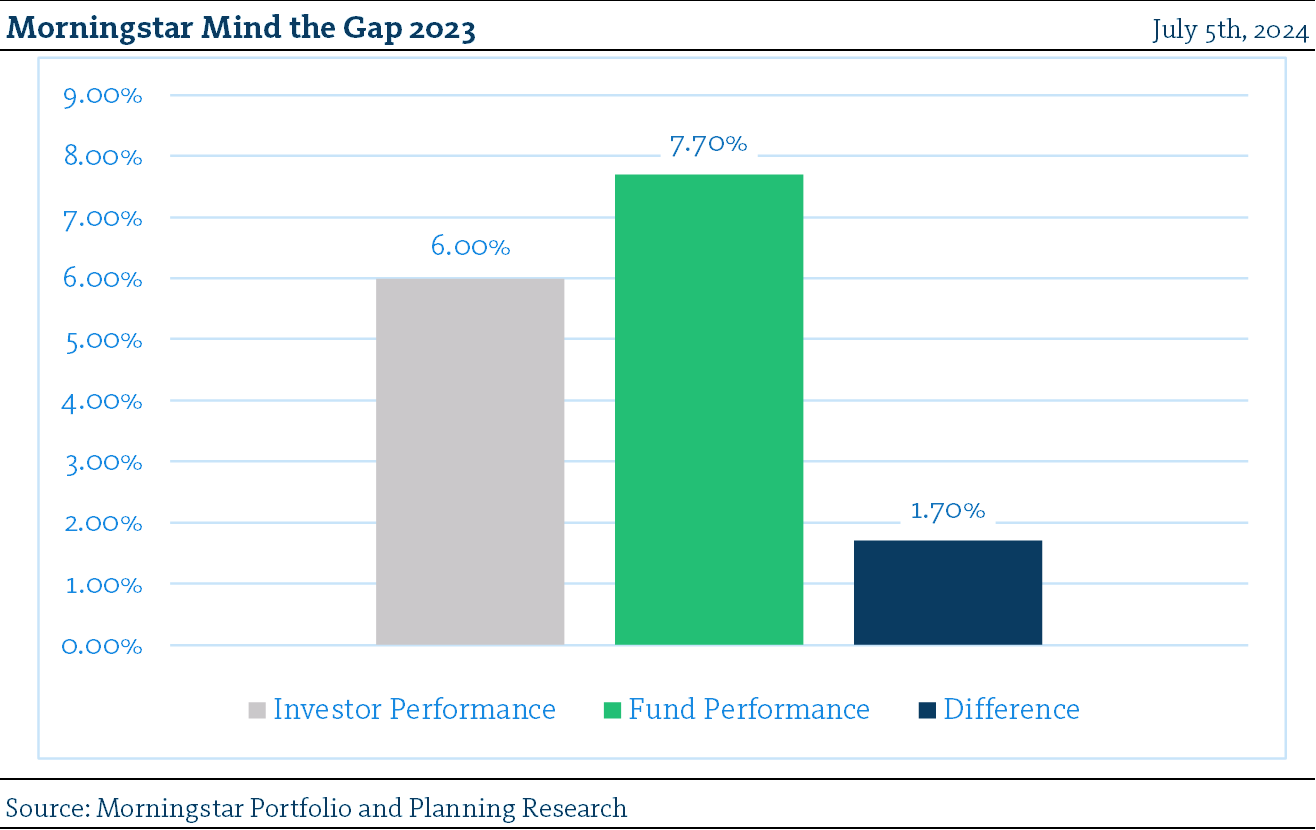The Investor Performance Gap
There is an interesting phenomenon in the investment industry where many investors tend to underperform compared to the funds they invest in. This is called the investor performance gap. This performance gap reflects the difference between the returns generated by fund holdings and the actual returns earned by investors. The variance is a result of purchase and sale timing, often attributed to performance chasing.
Morningstar’s Research team conducted a study of US investor returns (dollar-weighted) vs. returns of funds (time-weighted) the investors owned. They found there was a gap of 1.7% between these two figures over the trailing 10 years ending Dec 31st, 2022. Investors earned 6% annualized while the funds generated a 7.7% annual total return over the same period. Other studies found similar findings with gaps over 1%. Investors were not experiencing the same rate of return as the funds they invested in. The study was published in Morningstar’s Mind the Gap 2023 report.

The performance gap was found to increase with the volatility of the fund. The most drastic example was Ark Innovation EFT’s ARKK fund. ARKK is an actively managed innovation fund run by Cathie Wood. Another Morningstar report noted that ARKK returned over 5% annualized since inception (as of May 2023). While individual investors experienced a much different return. Their annualized average return was below -25%. Investors were drawn to ARKK due to the strong performance in 2019 and 2020. However, in 2021 and 2022 the fund had calendar year returns of -23.4% and -67% respectively. This meant many of the investors that came chasing the performance of ’19 and ’20, were stung by the significant pullback in ’21 and ’22.
“This means that” understanding this discrepancy between investor returns and fund performance is important. It highlights the value of having a sound investment strategy that is tailored to individual needs and can be adhered to over the long term. For our clients, we help establish such strategies and provide guidance to ensure they stay on track. After all, long term investment success is more about time in the market, not timing the market.
National Instrument 31-103 requires registered firms to disclose information that a reasonable investor would expect to know, including any material conflicts with the firm or its representatives. Doug Johnson and/or Pathfinder Asset Management Limited are an insider of companies periodically mentioned in this report. Please visit www.paml.ca for full disclosures.
Changes in Leverage. We are increasing the asset ceiling to 2.0 times the market value of equity for Pathfinder International Fund and Pathfinder Conviction Fund to be consistent with Pathfinder Partners’ Fund and Pathfinder Resource Fund.
*All returns are time weighted and net of investment management fees. Returns from the Pathfinder Partners’ Fund and Partners’ Real Return Plus Fund are presented based on the masters series of each fund. The Pathfinder Core: Equity Portfolio and The Pathfinder Core: High Income Portfolio are live accounts. These are actual accounts owned by the Pathfinder Chairman (Equity) and client (High Income) which contain no legacy positions, cash flows or other Pathfinder investment mandates or products. Monthly inception dates for each fund and portfolio are as follows: Pathfinder Core: Equity Portfolio (January 2011), Pathfinder Core: High Income Portfolio (October 2012) Partners’ Fund (April 2011), Partners’ Real Return Plus Fund (April, 2013), and Partners’ Core Plus Fund (November 2014).
Pathfinder Asset Management Limited (PAML) and its affiliates may collectively beneficially own in excess of 10% of one or more classes of the issued and outstanding equity securities mentioned in this newsletter. This publication is intended only to convey information. It is not to be construed as an investment guide or as an offer or solicitation of an offer to buy or sell any of the securities mentioned in it. The author has taken all usual and reasonable precautions to determine that the information contained in this publication has been obtained from sources believed to be reliable and that the procedures used to summarize and analyze such information are based on approved practices and principles in the investment industry. However, the market forces underlying investment value are subject to sudden and dramatic changes and data availability varies from one moment to the next. Consequently, neither the author nor PAML can make any warranty as to the accuracy or completeness of information, analysis or views contained in this publication or their usefulness or suitability in any particular circumstance. You should not undertake any investment or portfolio assessment or other transaction on the basis of this publication, but should first consult your portfolio manager, who can assess all relevant particulars of any proposed investment or transaction. PAML and the author accept no liability of any kind whatsoever or any damages or losses incurred by you as a result of reliance upon or use of this publication.